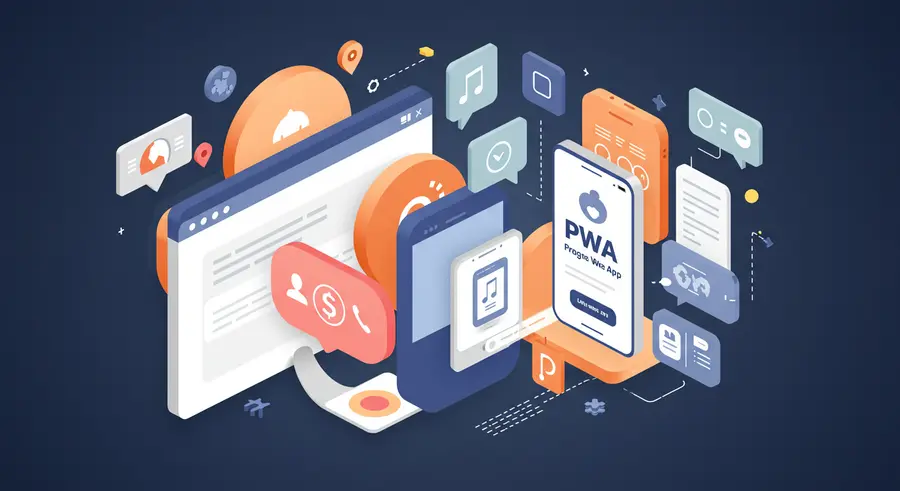Appearance

Welcome, tech enthusiasts! 👋 Today, we're diving deep into the exciting realm of Progressive Web Apps (PWAs). If you've ever wished your website could act more like a native mobile app – installable, offline-capable, and blazing fast – then PWAs are exactly what you've been looking for!
What Exactly Are Progressive Web Apps? 🌐📱
Imagine a website that blends the best of both worlds: the reach and discoverability of the web with the rich, engaging experience of a native mobile application. That's a PWA in a nutshell! They aren't new frameworks or languages; rather, they are web applications built with standard web technologies (HTML, CSS, JavaScript) but enhanced with modern browser capabilities to deliver an app-like experience.
The "Progressive" in PWA means they work for any user, regardless of browser choice, because they are built with progressive enhancement as a core tenet. They are:
- Reliable: Load instantly and never show the "downasaur," even in uncertain network conditions.
- Fast: Respond quickly to user interactions with silky smooth animations and no janky scrolling.
- Engaging: Feel like a natural app on the device, with an immersive user experience.
Why Should You Care About PWAs? The Benefits Are Huge! ✨
PWAs offer a compelling alternative to traditional native apps, especially for businesses looking to expand their reach and improve user engagement without the overhead of maintaining separate codebases for iOS and Android. Here are some key benefits:
- Offline Capability & Reliability: Thanks to Service Workers, PWAs can cache resources and data, allowing them to function even when the user is offline or has a flaky network connection. This means no more frustrating empty screens! Think of ordering your coffee on the Starbucks PWA even when your internet is spotty.
- Faster Load Times & Performance: By leveraging caching and optimized loading strategies, PWAs can load significantly faster than traditional websites, leading to better user retention and conversion rates. Trivago, for example, saw a 150% increase in pages visited per session after implementing their PWA.
- Installable & App-like Experience: Users can "install" a PWA directly to their device's home screen, just like a native app, without going through an app store. This provides a full-screen, immersive experience, complete with an app icon.
- Push Notifications: Re-engage users with timely and relevant push notifications, even when they are not actively using the app. This is a powerful tool for driving user engagement and retention.
- Cost-Effective Development & Maintenance: Developing a single PWA codebase for all platforms is often more economical and faster than building separate native apps for iOS and Android. Updates are also seamless, as they are deployed directly to the web.
- Improved SEO & Discoverability: Since PWAs are essentially websites, they are discoverable by search engines. This means your "app" can be found through web searches, unlike native apps that are confined to app stores.
- Responsive Design: PWAs are built with responsiveness in mind, adapting seamlessly to any screen size and device, from desktops to tablets and smartphones.
Real-World Examples of PWA Success Stories 🏆
Many well-known companies have embraced PWAs and reaped significant rewards:
- Twitter Lite: A great example of a fast, data-efficient, and engaging PWA that provides a native-like experience on mobile web.
- Starbucks: Allows customers to browse the menu, customize orders, and even order offline.
- Pinterest: Saw a 60% increase in core engagements and a 40% increase in time spent on their PWA.
- Uber: Offers a lightweight PWA for riders in areas with limited connectivity.
How Do PWAs Work Under the Hood? 🛠️
The magic behind PWAs lies in a few key technologies:
- Service Workers: These are JavaScript files that run in the background, separate from the main browser thread. They act as a programmable proxy, intercepting network requests, caching resources, and enabling offline capabilities and push notifications.
- Web App Manifest: A simple JSON file that provides information about the PWA to the browser, such as its name, icons, start URL, display mode (fullscreen, standalone), and theme colors. This allows the browser to present the PWA to the user as a native application.
- HTTPS: Security is paramount for PWAs. All PWAs must be served over HTTPS to ensure that the connection between the user and the server is secure and that the service worker cannot be tampered with.
Ready to Dive Deeper? 🧐
If you're interested in exploring the technical aspects of PWAs further, including how to build them, check out our catalogue page on this topic: The Power of Progressive Web Apps (PWAs).
Conclusion: The Future is Progressive! 🌟
Progressive Web Apps are not just a trend; they represent a significant step forward in web development, blurring the lines between web and native applications. They empower developers to build fast, reliable, and engaging experiences that are accessible to everyone, everywhere, regardless of their device or network conditions.
Embrace PWAs, and unlock a new level of performance and user engagement for your web presence!
#PWA #WebDevelopment #ProgressiveWebApp #FrontEnd #TechTrends #WebTech #ServiceWorker #Manifest #OfflineFirst